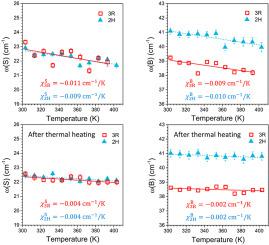Current Applied Physics ( IF 2.4 ) Pub Date : 2021-03-02 , DOI: 10.1016/j.cap.2021.02.011 Hanul Kim , Hayoung Ko , Soo Min Kim , Heesuk Rho

|
We report low-frequency Raman scattering results of bilayer (2L) MoS2 structures with 3R and 2H stacking orders. The stacking orders were identified by Raman mapping images of the low-frequency shear (S) and layer breathing (B) modes. Linear temperature coefficients () were obtained from temperature-dependent frequency changes of the shear and layer breathing modes for the 3R- and 2H-stacked 2L MoS2: , , , and . Interestingly, the temperature coefficients were significantly reduced after the MoS2 samples were thermally heated: , , , and . Similar behaviors were also observed for the temperature coefficients of the high-frequency and phonons. The heating-induced modifications in the temperature coefficients are attributed to changes in the MoS2–substrate coupling. Our result further paves the way for optimal design strategies for low-dimensional device applications where thermal management plays a crucial role in device performance.
中文翻译:

双层MoS 2中剪切和层呼吸模式的温度相关拉曼光谱
我们报告双层(2L)MoS 2结构具有3R和2H堆叠顺序的低频拉曼散射结果。通过低频剪切(S)和层呼吸(B)模式的拉曼映射图像确定堆叠顺序。线性温度系数()是从3R和2H堆叠的2L MoS 2的剪切和层呼吸模式的温度相关频率变化获得的:, , , 和 。有趣的是,在加热MoS 2样品后,温度系数显着降低:, , , 和 。高频的温度系数也观察到类似的行为 和 声子。加热引起的温度系数的变化归因于MoS 2-衬底耦合的变化。我们的结果进一步为热管理在设备性能中发挥关键作用的低尺寸设备应用铺平了最佳设计策略的道路。











































 京公网安备 11010802027423号
京公网安备 11010802027423号